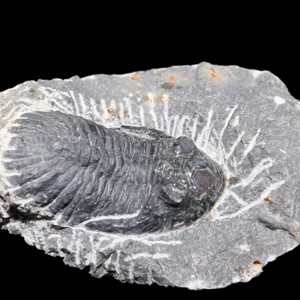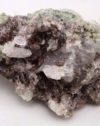HISTORY, NAME, LOCALITIES: Trilobite fossils have been known since prehistory. The name was assigned in 1826 and stems from the Greek trilobos, meaning “three-lobed” and alluding to the one axial and two lateral lobes that divide their body longitudinally. Trilobite fossils occur worldwide in Paleozoic marine sediments. Notable sources are in Morocco, Australia, China, and Canada.
PALEOBIOLOGY, OCCURRENCE: Trilobite fossils are the silicified remains of the chitinous exoskeletons of marine arthropods that lived from 540 to 240 million years ago. Their evolution and extinction roughly mark the beginning and end of the Paleozoic Age. Trilobites, the first life form with complex eyes, are the distant relatives of modern lobsters, crabs, and spiders. Paleontologists have identified more than 20,000 paleospecies. After burial in seafloor sediments, trilobite exoskeletons became fossilized by silicification. Trilobite fossils are found worldwide in Paleozoic marine limestone and often exhibit extraordinary preservation of detail.
METAPHYSICAL PROPERTIES, LORE: Trilobite fossils have been found in human cultural sites as old as 50,000 years and may have been the first fossils ever collected. Ancient Egyptian, Greek, and Roman tombs have yielded trilobite fossils with drill holes indicating that they were worn as amulets. Metaphysical practitioners believe that trilobite fossils promote leadership and management skills, and assist in development of strength and perseverance.
COLLECTORS’ INFORMATION: Because of their great age, extraordinary detail, and large number of species, trilobites are among the widely collected of all fossils. Specimens are often “reliefed” to better expose the fossil from its limestone matrix.





 Axinite #10
Axinite #10  Axinite #8
Axinite #8